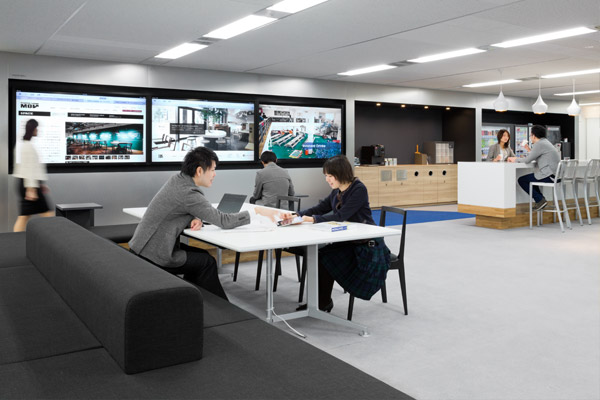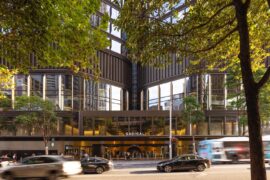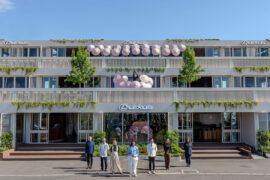The way we work is changing – this we know. But while the subject of agile working has been discussed at great length, few have aspired to walk-the-walk and adopt the radical changes the concept presents. By Sophia Watson.

December 17th, 2013
Since the opening of its new head office building in 1969, KOKUYO has consistently been a driving force behind advanced office projects and internal explorations of workplace movements. The so-called ‘modern workplace’ has a strong focus on integration, connectivity, technology and a notable levelling of hierarchy.
The KOKUYO ‘Next Office’ – a ‘live office’ in Tokyo’s Kasumigaseki –aims to explore and integrate these ideas by taking the ‘modern workplace’ to a higher level. Located on the 18th floor of the prestigious Kasumigaseki Building in Tokyo, this ‘living’ office is structured to achieve something critical to this new way of working – transparency.
Using Cloud technology to facilitate communications with no restrictions involving time or place, is just the beginning of the shift. Hosting a phenomenal 300 employees in the space, the 2,400 square metres are utilised to engage all company players, and create a borderless environment of intense collaboration and inter-office engagement.
Here, the open plan layout merges all departments to encourage a more cohesive work style. The meeting rooms – or ‘sync’ rooms – are private, yet entirely transparent with floor to ceiling glass barriers, again breaking down the idea of separation, fostering openness and team cohesion.
Free address seating is another initiative being applied in the space, where there is no assigned or ‘owned’ seating – even KOKUYO’s CEO Hidekuni Kurodahas has no personal office or reserved desk in the office.
The work areas themselves are varied, with a number of settings designed to accommodate a range of needs and functions. For example, there are solo work desks, team hubs, team booth collaboration spaces, relaxation areas, private meeting rooms, shared desks, community salons, show-and-tell facilities and so-on. But the Next Office represents far more than fancy features.
The office is an innovative space for new ways of working that produce strong bonds within a team, challenge traditional ideas of hierarchy, and shift the balance of power from the supervisor to the individual users.
The modern workplace is not just about installing an open floor plan, nor is it about merely letting individuals sit where they want. It is about adopting a radical attitude shift in your approach to working – a fundamental synergy between behaviour and mindset. KOKUYO understands this principle, and through the Next Office and other projects, continually plays with complex ideas of environment and work, designing proposals ahead of their time.
KOKUYO
kokuyo.com/en
INDESIGN is on instagram
Follow @indesignlive
A searchable and comprehensive guide for specifying leading products and their suppliers
Keep up to date with the latest and greatest from our industry BFF's!

Rising above the new Sydney Metro Gadigal Station on Pitt Street, Investa’s Parkline Place is redefining the office property aesthetic.

London-based design duo Raw Edges have joined forces with Established & Sons and Tongue & Groove to introduce Wall to Wall – a hand-stained, “living collection” that transforms parquet flooring into a canvas of colour, pattern, and possibility.
The internet never sleeps! Here's the stuff you might have missed

Several design groups are coming together on 29th October, 2025 for ‘grounded,’ a day of talks and workshops on Country-centred design.

Melbourne interior designer Brahman Perera creates three-level trackside space exploring synthesis of craft and technology.